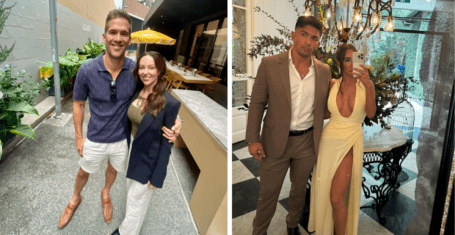
Review: Violin and Piano Recital at Trinity
JOE CONWAY : ‘One of the great things about classical music is the way it can plunge you directly into another world, another time, and another culture. Not to mention the mindset of the composer.’
5th June 6.30pm at Trinity College Chapel. £15/£10/£5
![]()
Andrea Cardinale and Alessandro Magnasco
Outside it was one of the warmest evenings of the year. But inside Trinity Chapel the temperature was even hotter for this violin and piano recital presented by the enterprising New Europe Society. Performing a busy programme of four sonatas, the playing of Andrea Cardinale and Alessandro Magnasco fairly sizzled at times. Their recital was a welcome reminder of the historic Italian tradition of violin playing, with its emphasis on passion, emotion, and fiery virtuosity.
Yet there was only one Italian work on the programme – the last of the charming short sonatas originally written for violin and guitar by Niccolo Paganini. This single movement piece contains two contrasted themes with opportunities for showmanship in the subsequent variations. Andrea Cardinale played the soulful opening melody with a penetrating tone which suited the Trinity acoustic and handled the technical details with aplomb. Swift double stops, a freely bouncing bow, and spectacular plucked string scales, all came across brilliantly.
Apart from a short encore by the Italian Baroque composer Francesco Veracini, the remainder of the programme was of works from the Austro-German tradition. In Mozart's early G major Sonata the music was played with pleasing freedom. The lovely first theme was held back nicely in places while the closing section of the exposition gathered speed. But this wayward approach only emphasised the variety of the music. True the instruments came adrift slightly in the second movement with pianist Alessandro Magnasco forcing the pace a little. But this could easily have been avoided with a little more rapport and eye contact between the musicians.
In Schumann's glorious Sonata in A minor however Andrea and Alessandro were together and at their best. One of the great things about classical music is the way it can plunge you directly into another world, another time, and another culture. Not to mention the mindset of the composer. Schumann's early romantic agenda is nearly always passionate, often turbulent. but usually shot through with moments of uplifting lyricism and glimpses of a better world. The two musicians revelled in the busy textures and the occasional moments of calm in the middle of the ongoing storm.
The only work on the programme which wasn't a sonata was Beethoven's F major Romance. Its main theme is a solemnly beautiful violin melody interspersed with sections for the piano which provide repetition and variation. A highlight was when a fragment of this tune occurs on the bottom violin string about two thirds of the way through the piece. Here Andrea produced a mellow golden tone before embarking on the more strident fanfares that eventually lead back to the main theme.
Beethoven's Spring Sonata is also in the key of F and is one of the best-known and best-loved of all fiddle sonatas. Its intricate opening theme is all sweetness and light and was performed gracefully and straightforwardly by Andrea Cardinale. But when Alessandro Magnasco played it subsequently the music was pulled about a lot more. This slight duality was soon dispelled however in the energetic music that follows – alarms and excursions, trumpets and drums, and the temperature definitely rising again . . .
Perhaps it was just as well that it was raining outside in the Great Court as the audience left the chapel. Phew!









































